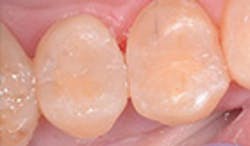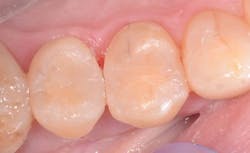Why bulk fill technology
By Darin O'Bryan, DDS
The placement of posterior composites has often troubled dentists. They can be time-consuming, technique-sensitive, and costly to do. There are a number of composites on the market that claim to be "bulk fill," implying we can reduce or eliminate multiple increments of applications. If that's the case, we would be able to tackle our operative dentistry more efficiently and more predictably. Fortunately, some bulk fill composites are "true" bulk fill composites that have the necessary ingredients to deliver on that promise. Let's look at the trials and tribulations of placing posterior composites and compare them to using Tetric EvoCeram Bulk Fill.
First, we need to consider how much time it takes to do a posterior composite. Posterior composites require a layered incremental curing strategy. Each layer can only be 2mm thick and needs to be cured for 10-20 seconds per layer. Due to the patented Ivocerin initiator with Tetric EvoCeram, you can fill up to 4mm with one placement and cure this for 10 seconds to get complete cure to the depth of the preparation. That is a time savings of 30-60 seconds per tooth. While for one tooth this may not seem like a lot, it quickly adds up when you start doing quadrant dentistry.
The stress relievers that are part of the new filler technology mean I am putting less stress on the composite, which leads to a number of advantages as well. Postoperative sensitivity is decreased due to less stress on the tooth. Also, the margins do not get the dreaded white line, indicating the bond is breaking down from too much shrinkage.
Okay, you're probably wondering, "If it cures so quickly, am I going to have to rush to get it done?" Not so. The special light filter means ambient light will not prematurely set the material. Also, the material is easy to adapt to the preparation, so placement time is reduced in trying to shape the anatomy. The ease of sculpting means less time refining anatomy and polishing, which again shaves off those precious seconds that add up to a big time savings.
Another property to look for in your bulk fill is whether or not it can blend with more than one tooth shade. The Tetric IvoCeram Bulk Fill IVA shade works for any shade in the "A" family. If I have an A1, I grab the IVA. If I have an A3, I grab the IVA. This simplifies my inventory and makes my assistant's life easier. It also means I don't have a bunch of half-empty shades left over. Also, because these fit into any composite gun, I don't have any special equipment I need to buy or transport between operatories.
True bulk fill composites make the placement of posterior composites much more efficient than other forms of composite. The time savings in curing alone is worth it. When you figure in reduced shade inventory, less stress on the tooth, less postoperative sensitivity, and decreased finishing and polishing time, bulk fill composites are a must for any dental armamentarium wanting predictable, efficient, and cost-effective posterior composites.
Darin O'Bryan, DDS, graduated in 1997 from the University of Minnesota School of Dentistry. He currently resides in Coos Bay, Oregon, where he has a private practice focusing on implant, esthetic, and digital dentistry. He is on the faculty at Spear Education with CERECdoctors.com, speaks on all areas of esthetic and implant dentistry, and works with numerous manufacturers in product evaluation and development.



